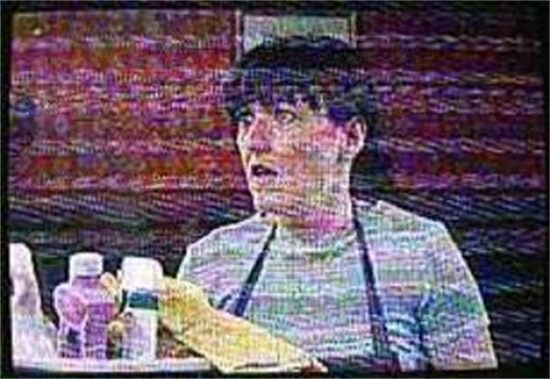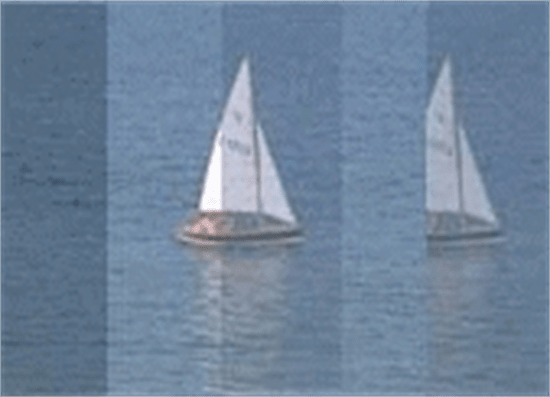Old Analogue Reception
Analogue Reception Problems and Solutions
Introduction.
This guide is included as a legacy guide for the old analogue RF transmissions, which ceased in 2012 over the UHF terrestrial network.
However, there are still products with analogue tuners and RF analogue modulate channels in the market. Primarily for the traditional Sky RF2 modulated output, CCTV or DVDs, etc, in both homes and commercial such as hotels and businesses. Not all the following interference problems will occur in these types of installations, but they are worth listing just in case.
Although not applicable to the DTT (Digital Television Transmission) if you are using an Analogue modulator to send CCTV or other signals around the house,
some of this article will still apply today.
No matter the problem, performing an initial check of the equipment is always good practice.
Initial checks of your equipment
- Check that your mains plug is wired correctly with tight electrical connections and that it is pushed firmly into the socket.
- Check that your aerial lead appears in good condition, with its plug firmly attached to it and making good contact when pushed into the aerial socket on the back of the TV set and equipment.
- Also check that the cable is of the correct quality; copper braid with copper or aluminium foil type cables are generally a minimum requirement, especially for digital reception.
- Hotels, blocks of flats and some housing estates use a communal aerial, which you cannot check yourself. If necessary, you should contact the landlord or his nominated contractor.
The following are typical examples of analogue reception problems and help in curing such problems.
Questions related to signal interference within the distribution system
- Q. TETRA interference
- Q. My TV has a strange pattern. (Radio interference)
- Q. I have lines or squares appearing across my screen. (Electrical interference)
- Q. LTE interference
- Q. Do It Yourself
- Q. I have tried all of the above suggestions, and it's still not right now.
How to find the source of interference
In many cases, the source of the interference will be obvious because the interference appears when an item such as an electric drill is being used. Where the source of interference isn't obvious, try to locate it by switching off everything in the home one item at a time while another monitors the effect on the TV screen.
Alternatively, if you have a portable radio and can hear the interference on it, take the radio from room to room to find where the interference is loudest.
All modern electrical equipment is manufactured to regulations requiring that interference suppressors be fitted. If you find an appliance causing interference and is still under warranty, send it back with a request that it be put right. Otherwise, ask an electrical dealer to fit a suppressor to it. Under no circumstances should you attempt this internal modification yourself.
A. What can you do?
- Always install an aerial with a balun.
- Combine a balun fitted aerial to good quality double-screened type coaxial cable.
- Avoid coupling joints in the cable; always aim to have one solid piece of cable to each outlet point.
- Install screened accessories such as wall plates.
- Do not run coaxial cable near to any source of electrical interference such as a thermostat or a motor.
Q. TETRA (Terrestrial Trunked Radio or Trans European Trunked Radio) interference
 This image shows how a strong TETRA transmission could affect your TV reception. TETRA interference on Digital pictures would look like the mosaic effect often found with other types of interference.
This image shows how a strong TETRA transmission could affect your TV reception. TETRA interference on Digital pictures would look like the mosaic effect often found with other types of interference.
A. What can you do?
- Many aerials have good out-of-band rejection performance, so changing aerial to a suitable one may be worthwhile.
- Re-positioning the aerial would also be a good idea, even if only the height and azimuth can be adjusted.
Install a simple passive TETRA filter. If also using an amplifier, then place the filter BEFORE the amplifier, or better still, install one with TETRA filtering included like our own range of Amplifiers.
Please also refer to our FAQ on TETRA Interference here.
Q. There is a strange pattern on my TV. (Radio interference)

Radio transmitters are used for communication by radio amateurs, radio taxis and many other licensed and authorised services. Strong transmissions from any of these sources could affect your TV reception.
In many cases, there is no fault with the radio transmitter, and the radio operator is not to blame. The problem could occur because the TV set is not designed well enough to resist signals it should not receive. In such cases, the TV set is said to lack immunity.
A. What can you do?
- You can cure many cases by fitting a simple plug-in high-pass filter between the plug on the end of the aerial lead and the aerial socket on the back of the TV set. A variety of suitable filters are available, and your dealer will advise you which ones to try.
- If the filter does not work, the TV set could require an internal modification to improve its immunity to interference.
- Many aerials have good out-of-band rejection performance, so changing aerial to one with good out-of-band rejection may be worthwhile.
- Also, many masthead and distribution amplifiers have filters fitted, so changing the amplifier to one with included filters could also help.
Q. I have lines or squares appearing across my screen. (Electrical interference)
 Examples of Electrical/Impulse Interference
Examples of Electrical/Impulse Interference
Because nearly half of all TV reception problems are due to deficiencies and faults in the TV set, the aerial lead or aerial, you should ensure your equipment is in good working order before checking for interference.
Many interference problems can be traced to domestic electrical equipment or appliances in your home or a neighbouring property.
Electrical/impulse interference is usually more noticeable with digital reception. The reception will appear to be breaking up or look like a mosaic pattern. If this occurs, the best solution is an aerial with a balun and a double-screened coaxial cable. Analogue cures below could also cure the problem. If this type of interference always appears on digital reception, and the picture also freezes, the reason is that the signal is not strong enough.
Some causes of electrical/impulse Interference
- Vacuum cleaners
- Fans
- Electric drills
- Electric trains
- Electric razors
- Sewing machines
- Automatic switches
- Central heating thermostats
- Refrigerators
- Freezers
This type of interference is normally caused by switches or thermostats, especially in central heating systems. It appears on the screen as a dense white band of spots or on digital pictures as a mosaic effect, but only for a short period of time.
Q. I have tried all of the suggestions that are still not right. What now?
In most cases, problems can be cured with slight adjustments to the installation. However, it is possible to get carried away with all the little tweaks here and there. If it is proving difficult to achieve the best reception possible and everything has been tried, it may be worthwhile to call out an experienced engineer, it is recommended that a CAI (Confederation Of Aerial Industries) registered engineer be used. It may be that the problems you are having are common in the area and the engineer may know a common cure.
Also in most cases, digital reception problems can be cured by the same methods adopted for analogue reception problems. Key components for a successful digital installation are a good quality high gain aerial (preferably a CAI benchmarked⁄certified model), good quality double screened cable and good quality screened outlet plates (if used). In addition to this, all cable connections should be kept to a minimum and should be tight and correct.
Q. How do I order your products?
Products can be ordered by one of the following methods:-- If you are an end user then either contacting your local professional installer or select the buy icon on the product pages.
- If you are trade installer and wish to find details of your local wholesaler, please fill in the appropriate details on our contact.
Legacy Questions related to the interference caused at the signal reception.
This section is irrelevant to any forms of interference, even with analogue redistribution, as the cause of the interference is more than one analogue signal being received through the aerial. We have included for posterity.
- Q.What was ghosting.
- Q.I have two channels or two images at the same time on my TV (Co-channel interference).
Q. What was Ghosting?

An example of "Ghosting"
This is the sort of picture you may have seen with analogue TV signals is reflected from a large building or other structure in your locality.
Why Ghosting Occurred
The problem was caused because both the direct signal and a reflected signal from the transmitter are being received. Because the reflected signal travels a greater distance before it arrives, it produces a picture shifted to the right of the normal picture.
Digital television uses a modulation system that has a lot of protection against multi-path reception (ghosting). In most cases where ghosting occurs on an analogue picture, the digital reception will be OK.
What you can do?
- A better picture can usually be obtained by altering the direction in which the aerial is pointing.
- Adjusting the height of the aerial is usually the best method to adopt.
- If ghosting is severe and persistent, a more directive aerial such as a high gain aerial or a log periodic type could be used. Another aerial that has been known to eliminate ghost signals is a Grid-type aerial.
I have two channels or two images at the same time on my TV (co-channel interference.)
 Examples of Co-channel interference
Examples of Co-channel interference
A distant transmitter usually causes co-channel Interference because it is transmitting on the same channel as the local transmitter from which the main signal is being received. This problem is rare, but unfortunately, it can happen due to the channel allocations of the vast number of transmitters nationwide.
Co-channel interference can affect digital reception by overloading; in this case the following analogue cures could cure the problem.
A. What you can do?
- It can be that the aerial installed has a very large viewing angle/beam width; an aerial such as a high gain that has a narrow viewing angle could solve the problem.
- Adjustments in height and left to right (azimuth) as per the ghosting example could solve the problem.
- If the problem is severe, it could be that the property's location means that the primary transmitter and the problem transmitter may be on the same bearing. In a case like this, the aerial must often be pointed in a different direction to receive from an alternative transmitter. This alternative transmitter could be further away from the original; therefore, amplification or a higher aerial gain may be required.
- Monitor the polarity of the aerial when searching for an alternative signal, as the alternative transmitter may transmit a vertically polarised signal; this means that the orientation of the aerial will need to be vertical.








 Quick Add
Quick Add